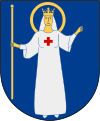Sodertalje
| Södertälje | ||
|---|---|---|

Panorama view of Södertälje from the new Saltsjöbron
|
||
|
||
| Coordinates: 59°11′45″N 17°37′41″E / 59.19583°N 17.62806°ECoordinates: 59°11′45″N 17°37′41″E / 59.19583°N 17.62806°E | ||
| Country | Sweden | |
| Province | Södermanland | |
| County | ||
| Municipality | Södertälje Municipality | |
| Founded | 1300s | |
| Area | ||
| • Total | 25.84 km2 (9.98 sq mi) | |
| Elevation | 23 m (75 ft) | |
| Population (2014) | ||
| • Total | 75,283 | |
| • Density | 170/km2 (400/sq mi) | |
| Time zone | CET (UTC+1) | |
| • Summer (DST) | CEST (UTC+2) | |
| Postal code | 151xx | |
| Area code(s) | (+46) 08 | |
| Vehicle registration | 0356 | |
| Website | www.sodertalje.se | |
Södertälje (Swedish pronunciation: [sœdɛ²ʈɛlːjɛ]) is a city and the seat of Södertälje Municipality, , Sweden with 75,283 inhabitants in 2014.
The industrial city, about 30 kilometers (19 mi) southwest of , is the home to truck maker Scania AB and the research and development arm of a top 10 pharmaceutical company AstraZeneca. Södertälje is an international municipality and this fact is reflected in business, cultural life and the population.
About 39 percent of Södertälje's inhabitants have foreign backgrounds, and this proportion increases by 1.5 percent per year. Western-Assyrians are one of the largest groups of immigrants in Södertälje.
Prior to 600 AD, the lake Mälaren was connected to the sea. Due to land elevation, the lake was slowly cut off, and boats had to be carried over land to and from the lake.
The name Telje is mentioned in the 11th century. To resolve a name conflict with another town that was founded north of Stockholm in the 17th century, Söder (meaning south) was added to create Södertälje; Norr (North) was added to the other to create Norrtälje.
In the 18th century Södertälje had a charter. Due to the Great Northern War and a series of plague epidemics, the population of the city dipped to barely above 200.
The first Assyrians arrived in 1967 as refugees from Turkey and were invited to settle here as workers for the understaffed factories in the area. However, the small community skyrocketed within a decade due to a war between Kurdish freedom fighters and the Turkish Government during the 1980s which displaced tens of thousands of Assyrians because it made the region they lived in, known as Tur Abdin, unsafe for them. In more recent times, the Iraqi insurgency (2003–11), and the Syrian Civil War have caused the Assyrian community to grow even larger.
...
Wikipedia


